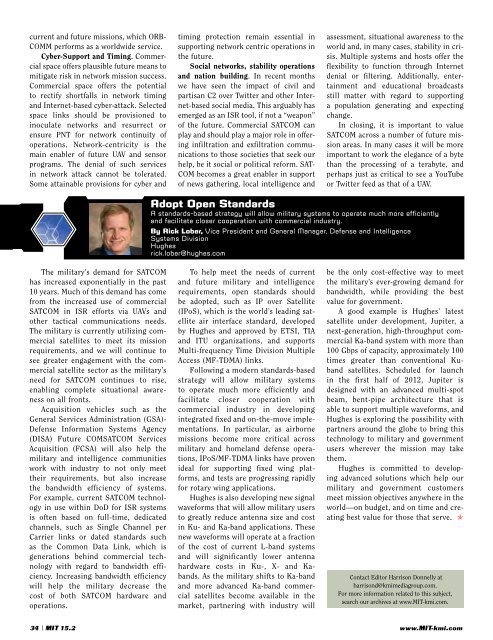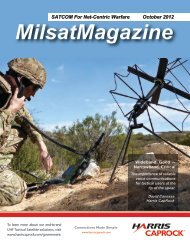Satcom for ISR - Harris CapRock
Satcom for ISR - Harris CapRock
Satcom for ISR - Harris CapRock
- No tags were found...
You also want an ePaper? Increase the reach of your titles
YUMPU automatically turns print PDFs into web optimized ePapers that Google loves.
current and future missions, which ORB-<br />
COMM per<strong>for</strong>ms as a worldwide service.<br />
Cyber-Support and Timing. Commercial<br />
space offers plausible future means to<br />
mitigate risk in network mission success.<br />
Commercial space offers the potential<br />
to rectify shortfalls in network timing<br />
and Internet-based cyber-attack. Selected<br />
space links should be provisioned to<br />
inoculate networks and resurrect or<br />
ensure PNT <strong>for</strong> network continuity of<br />
operations. Network-centricity is the<br />
main enabler of future UAV and sensor<br />
programs. The denial of such services<br />
in network attack cannot be tolerated.<br />
Some attainable provisions <strong>for</strong> cyber and<br />
timing protection remain essential in<br />
supporting network centric operations in<br />
the future.<br />
Social networks, stability operations<br />
and nation building. In recent months<br />
we have seen the impact of civil and<br />
partisan C2 over Twitter and other Internet-based<br />
social media. This arguably has<br />
emerged as an <strong>ISR</strong> tool, if not a “weapon”<br />
of the future. Commercial SATCOM can<br />
play and should play a major role in offering<br />
infiltration and exfiltration communications<br />
to those societies that seek our<br />
help, be it social or political re<strong>for</strong>m. SAT-<br />
COM becomes a great enabler in support<br />
of news gathering, local intelligence and<br />
assessment, situational awareness to the<br />
world and, in many cases, stability in crisis.<br />
Multiple systems and hosts offer the<br />
flexibility to function through Internet<br />
denial or filtering. Additionally, entertainment<br />
and educational broadcasts<br />
still matter with regard to supporting<br />
a population generating and expecting<br />
change.<br />
In closing, it is important to value<br />
SATCOM across a number of future mission<br />
areas. In many cases it will be more<br />
important to work the elegance of a byte<br />
than the processing of a terabyte, and<br />
perhaps just as critical to see a YouTube<br />
or Twitter feed as that of a UAV.<br />
Adopt Open Standards<br />
A standards-based strategy will allow military systems to operate much more efficiently<br />
and facilitate closer cooperation with commercial industry.<br />
By Rick Lober, Vice President and General Manager, Defense and Intelligence<br />
Systems Division<br />
Hughes<br />
rick.lober@hughes.com<br />
The military’s demand <strong>for</strong> SATCOM<br />
has increased exponentially in the past<br />
10 years. Much of this demand has come<br />
from the increased use of commercial<br />
SATCOM in <strong>ISR</strong> ef<strong>for</strong>ts via UAVs and<br />
other tactical communications needs.<br />
The military is currently utilizing commercial<br />
satellites to meet its mission<br />
requirements, and we will continue to<br />
see greater engagement with the commercial<br />
satellite sector as the military’s<br />
need <strong>for</strong> SATCOM continues to rise,<br />
enabling complete situational awareness<br />
on all fronts.<br />
Acquisition vehicles such as the<br />
General Services Administration (GSA)-<br />
Defense In<strong>for</strong>mation Systems Agency<br />
(DISA) Future COMSATCOM Services<br />
Acquisition (FCSA) will also help the<br />
military and intelligence communities<br />
work with industry to not only meet<br />
their requirements, but also increase<br />
the bandwidth efficiency of systems.<br />
For example, current SATCOM technology<br />
in use within DoD <strong>for</strong> <strong>ISR</strong> systems<br />
is often based on full-time, dedicated<br />
channels, such as Single Channel per<br />
Carrier links or dated standards such<br />
as the Common Data Link, which is<br />
generations behind commercial technology<br />
with regard to bandwidth efficiency.<br />
Increasing bandwidth efficiency<br />
will help the military decrease the<br />
cost of both SATCOM hardware and<br />
operations.<br />
To help meet the needs of current<br />
and future military and intelligence<br />
requirements, open standards should<br />
be adopted, such as IP over Satellite<br />
(IPoS), which is the world’s leading satellite<br />
air interface standard, developed<br />
by Hughes and approved by ETSI, TIA<br />
and ITU organizations, and supports<br />
Multi-frequency Time Division Multiple<br />
Access (MF-TDMA) links.<br />
Following a modern standards-based<br />
strategy will allow military systems<br />
to operate much more efficiently and<br />
facilitate closer cooperation with<br />
commercial industry in developing<br />
integrated fixed and on-the-move implementations.<br />
In particular, as airborne<br />
missions become more critical across<br />
military and homeland defense operations,<br />
IPoS/MF-TDMA links have proven<br />
ideal <strong>for</strong> supporting fixed wing plat<strong>for</strong>ms,<br />
and tests are progressing rapidly<br />
<strong>for</strong> rotary wing applications.<br />
Hughes is also developing new signal<br />
wave<strong>for</strong>ms that will allow military users<br />
to greatly reduce antenna size and cost<br />
in Ku- and Ka-band applications. These<br />
new wave<strong>for</strong>ms will operate at a fraction<br />
of the cost of current L-band systems<br />
and will significantly lower antenna<br />
hardware costs in Ku-, X- and Kabands.<br />
As the military shifts to Ka-band<br />
and more advanced Ka-band commercial<br />
satellites become available in the<br />
market, partnering with industry will<br />
be the only cost-effective way to meet<br />
the military’s ever-growing demand <strong>for</strong><br />
bandwidth, while providing the best<br />
value <strong>for</strong> government.<br />
A good example is Hughes’ latest<br />
satellite under development, Jupiter, a<br />
next-generation, high-throughput commercial<br />
Ka-band system with more than<br />
100 Gbps of capacity, approximately 100<br />
times greater than conventional Kuband<br />
satellites. Scheduled <strong>for</strong> launch<br />
in the first half of 2012, Jupiter is<br />
designed with an advanced multi-spot<br />
beam, bent-pipe architecture that is<br />
able to support multiple wave<strong>for</strong>ms, and<br />
Hughes is exploring the possibility with<br />
partners around the globe to bring this<br />
technology to military and government<br />
users wherever the mission may take<br />
them.<br />
Hughes is committed to developing<br />
advanced solutions which help our<br />
military and government customers<br />
meet mission objectives anywhere in the<br />
world—on budget, and on time and creating<br />
best value <strong>for</strong> those that serve. O<br />
Contact Editor <strong>Harris</strong>on Donnelly at<br />
harrisond@kmimediagroup.com.<br />
For more in<strong>for</strong>mation related to this subject,<br />
search our archives at www.MIT-kmi.com.<br />
34 | MIT 15.2<br />
www.MIT-kmi.com




